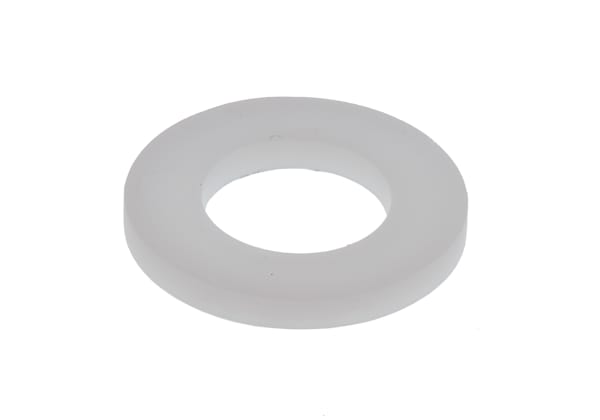- Published 17 Jan 2023
- Last Modified 29 Aug 2023
- 8 min
A Complete Guide to Locking Nuts
Read our locking nuts guide to understand how they work, the different types, how to use them, and common sizes.

This guide aims to provide an understanding of what lock nuts do, how they function, and which types are available online in the UK. We also answer key FAQs about locknuts.
Additionally, we will highlight some of the most popular types you can buy online, including a brief discussion of how to use lock nuts, and how to pick out the right locking nut sizes for your needs.
What is a Locking Nut?
Locking nuts or lock nuts are special types of fastener designed to achieve a secure fixing. Some suppliers call them self-locking nuts or stiffnuts. They are screwed onto a bolt or threaded rod just like standard nuts, but a lock nut will then resist loosening under torque or vibration forces.
Lock nuts or stiff nuts were invented in the 1930s to cut down on the cost of nut and washer use in various types of machine assemblies. Before this, the best way to prevent nuts loosening due to vibration was to use two standard nuts on a single bolt. However, this doubled the cost of nuts and washers for each bolt in the assembly.
Since individual nuts cost very little to make or buy, doubling up in this way is still a relatively cheap solution at low production volumes. However, it becomes exponentially more expensive at scale, and so the self-locking nut was conceived as a more economical way around the problem of unwanted loosening.
While locknuts themselves are individually more expensive than non-locking versions, they are still a cheaper solution than buying and using two standard nuts. Today, you will find locking nuts used on all manner of screwed rod and threaded studding assemblies across countless industries and applications.
How Do Lock Nuts Work?
Lock nuts work similarly to other threaded fasteners and fixings when attached to the shaft of a bolt or screwed rod. The key difference is that locking nuts are manufactured and machined in such a way that they won’t easily back off (work themselves loose) once screwed on.
This makes lock nuts especially useful in applications where the bolt or nut assembly will be subject to vibrating or torque forces while installed. An obvious example of this is in engines and other automotive parts. They are also widely used in various other mechanical and industrial applications.
Most locking nuts work in one of two ways. Some are manufactured to provide increased friction once affixed, often via threading designs including pitted or flanged grooves. Others are designed with some form of a positive locking device or mechanism built-in - some metal locking nuts, for example, feature a small metal lip or crown that can be crimped inward once installed. This will then physically hold the nut tight to the bolt shaft and prevent it from loosening under vibration.
Each of these two main categories of lock nuts has various subtypes. We will discuss some of the most popular models of these in more detail below.
Locking Nut Types
There are numerous different lock nut types widely sold online in the UK. They broadly fall into two main categories, known as prevailing torque nuts and surface bearing lock nuts.
Prevailing Torque Nuts
A prevailing torque lock nut relies on the principle of prevailing torque to resist vibration loosening. In this context, prevailing torque is the amount of force required to run the nut down the threaded shaft of a bolt or screwed rod, such that the nut grips tightly and does not back off easily.
Specific examples of prevailing torque lock nuts include conical lock nuts, tri-lock nuts, top lock, Stover lock nut, and Griptite nuts. Most are all-metal lock nuts, and many have some sort of lip or crown that is designed to be crimped around a bolt shaft after installation. This crimping process is what creates enough prevailing torque to hold the lock nut in place, even during heavy vibration.
However, not all prevailing torque or all-metal nuts will have a crimpable section. Some are designed to create prevailing torque through different mechanisms, such as conical flange lock nuts. Many of these types of nuts will need to be wrenched in either direction, whether installing or removing them.
Surface Bearing Lock Nuts
A surface bearing locking nut spins freely under normal circumstances, but that can be tightened against a bearing surface to activate a locking mechanism that holds it firmly in place.
Frequently bought examples of lock nut types in widespread use include:
- Nylon insert lock nuts - featuring an inner sleeve that moulds to the threading pattern
- Hex jam nuts - effectively a double-nut system, in which two pieces are tightened against one another
- Prevailing torque or Stover locking nuts
- Centre locknuts (also known as two-way locking nuts) - a common subtype of distorted thread nuts, where the nut threading is deliberately designed to interfere with and ultimately bind against the bolt threading
- Serrated flange lock nuts - another subtype of distorted thread locking nuts
- Top lock nuts
- Jet nuts or K-lock nuts
- Castellated or castle-lock nuts
The best locking nuts for your needs will depend on the various specifics of the task at hand. Important things to consider include:
- Thread direction - lock nuts can be bought with clockwise (right-hand) or anticlockwise (left-hand) threading
- The size of stiffnuts you require, in metric or imperial standards
- The type of assembly they are being used with and the environment that a locking nut will be exposed to during its working life
- Whether or not the nut you choose requires any secondary components, such as a specific washer, to lock properly
- The material your locking nut is made from
There are several subsets of the main types available, as well as a few more specialised models for highly specific applications. Some of the more popular variants are defined below.
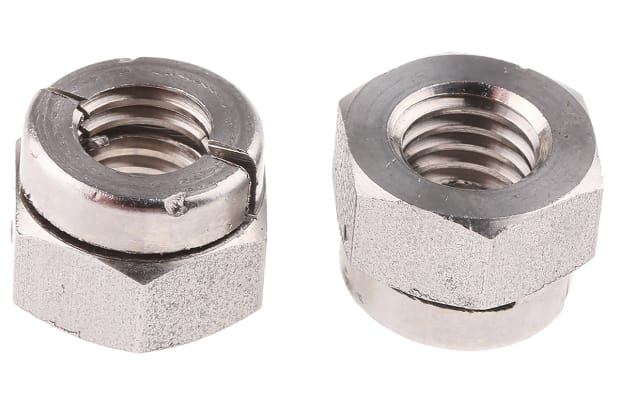
Aerotight Nuts
An Aerotight nut is a brand name used to describe an all-metal (stainless steel) stiff nut, sometimes referred to as bent beam nuts. They have a self-locking mechanism built-in, meaning they can be used and reused many times. They do not require any additional components and are designed to remain in place whether they are fully tightened down.
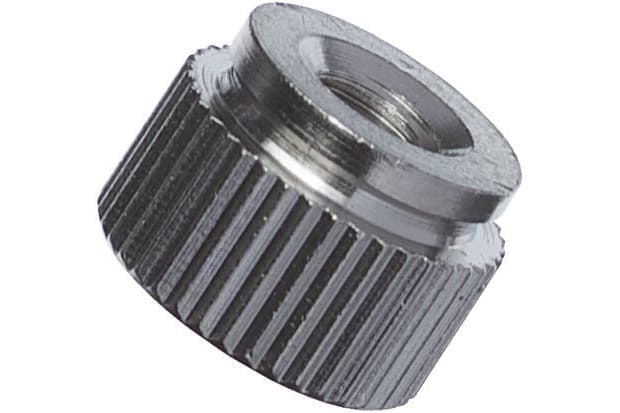
Knurled Nuts
Knurled nuts feature a knurling pattern around the outside edge, offering a better finger grip. Along with thumb nuts and insertion nuts, a knurled nut is a type of locking nut designed to be manually tightened and loosened. In other words, it is a type of hand nut, as opposed to one that is meant to be wrenched into place. However, some models are available with screwdriver drive slots in the head.
As they are mainly intended for hand-tightening, they are chosen less often for applications where the nut must be cranked extremely tightly against a threaded rod or bolt. They are handy in situations where a locking nut will need to be removed and replaced regularly, or where you want to remove the risk of over-tightening or stripping.
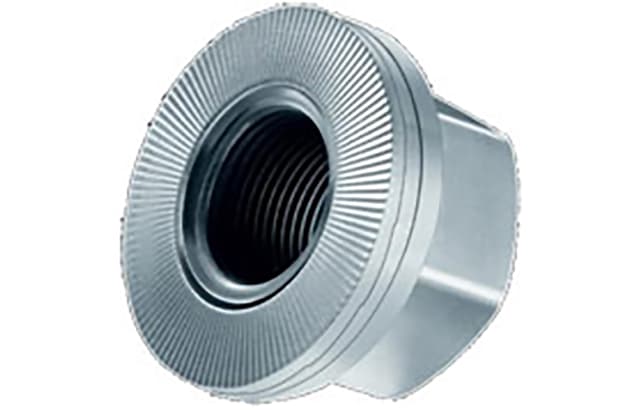
Wedge Lock Nuts
A wedge-lock nut combines the nut itself along with a wedge lock washer, which features a cam with a rise to it that is greater than the thread pitch of the bolt. They are often supplied pre-assembled, meaning they are a single-piece fastener. They can be used repeatedly on bolted joints and are suitable for demanding applications (including under heavy loads and vibration).
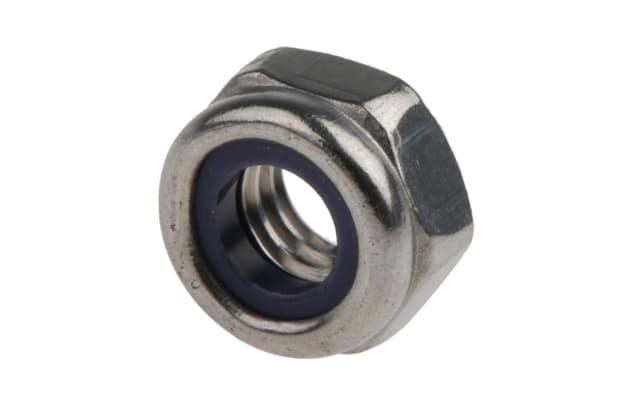
Nylon Insert Lock Nuts
Nylon insert lock nuts are a popular and widely used type of locking nut, thanks to being cheap to buy and effective in a wide range of environments. They feature an inner sleeve made from nylon plastic, which is intended to deform around the bolt threads and create binding friction.
As the sleeve of a nylon insert lock nut deforms in this way on attachment, they are less easy to reuse multiple times than some other types. However, it is a useful design for securely joining softer materials like wood and plastic, without the risk of over-tightening damaging the surface of the material. They work well at resisting vibration loosening and are often used for applications like domestic appliances and automotive repair.
Nylon insert lock nut colours are usually black, grey or white (for the sleeve itself), but many other colours of the plastic inner sleeve are available. The nut itself will commonly be stainless steel, zinc or brass.
How to Use Locking Nuts
When it comes to the question of how to lock nuts on bolts, the answer varies slightly according to which exact type of locking nut you are using. However, for the most part, the initial threading and finger-tightening works just like it would with a standard hex nut. In many cases, you would then need to tighten the lock nut further with a wrench or similar tool, until you achieve the required grip.
For some types, deciding which end of a lock nut goes on first is simple, as certain friction or torque-based designs dictate that a nut will only lock properly when fastened in one direction. However, you will need to pay attention to whether you are using a locknut with clockwise or anticlockwise threading.
For other designs and brands of locking nuts, it may be necessary to use a lock nut washer alongside the nut itself to achieve the full lock.
FAQs
What are Lock Nut Thread Sizes?
Common lock nut thread sizes (usually given in metric or M measurements) include M3, M4, M5 lock nuts, M6, M8, M10, M12, M16, and M20. These will cover most standard domestic uses, although locking nuts ranging from M25 to M50, M60, and even M85 are also widely available online.
What is the Standard Locking Nut Width?
A 10mm lock nut is a common width for many types of jobs and applications, although again, this is far from the only width available. Usually given in mm, standard sizes for locking nut widths include 5.5mm, 6mm, 7mm, 8mm, 11mm, 12mm, and 13mm.
What are Locking Nuts Made of?
For heavy-duty and industrial applications, all metal lock nuts such as stainless-steel lock nuts, mild steel, zinc, or brass locking nuts are preferred. However, part-nylon or all-plastic lock nuts are also popular in many applications, provided the torque forces they will need to withstand are not too severe.
